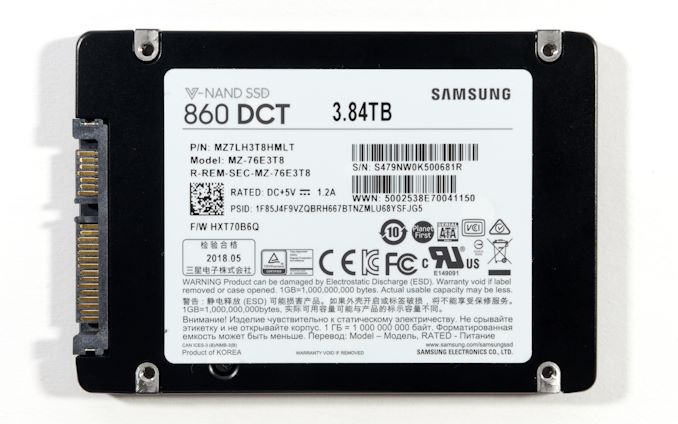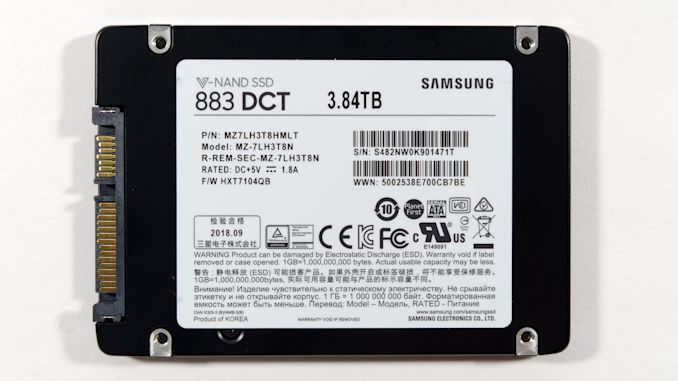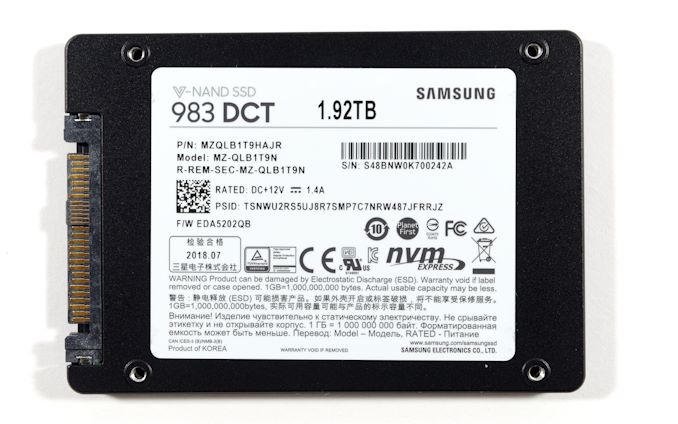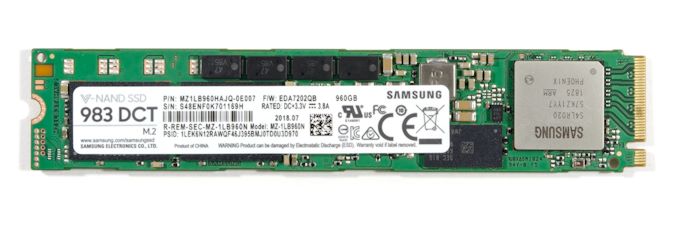The Enterpise TLC Storage Era Begins: Rounding Up 13 SSDs With Samsung, Intel, and Memblaze
by Billy Tallis on January 3, 2019 9:45 AM ESTSamsung's Latest Datacenter SSDs
In the latter half of this year, Samsung launched several new enterprise/datacenter SSD product lines. This is part of a new strategy to make its enterprise storage products more accessible to smaller customers. The 860 DCT, 883 DCT, 983 DCT and 983 ZET all use hardware that Samsung was already selling under different names, but are now being sold by retailers in individual quantities. We'll be testing the 983 ZET next month, but the other three new models have already survived our testing.
Samsung 860 DCT
The Samsung 860 DCT uses the same hardware as the 860 EVO consumer SSD, but with enterprise-oriented firmware. That means SLC caching is out and the firmware is optimized to provide consistent sustained performance, even though that means peak write speeds are far lower and the usable capacity is 4% lower due to increased overprovisioning. The 860 DCT also doesn't offer the idle power saving modes that consumer drives feature. The 860 DCT is an entry-level server drive that lacks many features traditionally associated with enterprise SSDs, most notably power loss protection capacitors. Like consumer SSDs, the 860 DCT operates with a volatile write cache, though this can be disabled at further cost to write performance.
| Samsung 860 DCT Specifications | ||||
| Capacity | 960 GB | 1.92 TB | 3.84 TB | |
| Controller | Samsung MJX | |||
| Form Factor | 2.5" 7mm SATA | |||
| NAND Flash | Samsung 64-layer 3D TLC | |||
| DRAM | 1 GB LPDDR4 | 2 GB LPDDR4 | 4 GB LPDDR4 | |
| Sequential Read | 550 MB/s | |||
| Sequential Write | 520 MB/s | |||
| Random Read | 98k IOPS | |||
| Random Write | 19k IOPS | |||
| Power Consumption | Read | 1.9 W | ||
| Write | 2.9 W | |||
| Idle | 1.05 W | |||
| Write Endurance | 349 TB 0.2 DWPD |
698 TB 0.2 DWPD |
1396 TB 0.2 DWPD |
|
| Warranty | 5 years | |||
The 860 DCT is intended for use primarily on very read-heavy workloads, with a very low volume of writes that preferably would be mostly sequential – for example, serving up streaming video. This is reflected by the write endurance rating of just 0.2 drive writes per day. Samsung doesn't intend for the 860 DCT to compete against any of their existing enterprise SSDs. Instead, they are targeting use cases where customers are currently using consumer-grade SSDs or mechanical hard drives.
This is pretty much the same description that everyone is giving for their first enterprise QLC SSDs, but the 860 DCT is still a TLC-based drive at this point. We expect its successor to switch to QLC NAND. Samsung says their currrent MJX controller can support 8TB SSDs, but so far they haven't gone beyond 4TB. As NAND and DRAM prices will continue to decline in 2019, it probably won't be long before they decide to max out the MJX controller.
The labeling on the 860 DCT differs slightly from Samsung's retail consumer SSDs, but inside we find exactly the same PCB, with components that differ only in date codes and lot numbers. Our 3.84 TB 860 DCT sample uses eight NAND packages each containing eight of Samsung's 512Gb 64-layer 3D TLC V-NAND, for a total raw capacity of 4 TiB.
Samsung 883 DCT
The Samsung 883 DCT is a more traditional enterprise SATA SSD, with the power loss protection capacitors that the 860 DCT lacks. The controller and NAND are still the same as in the 860 DCT and consumer 860 EVO. Random write performance is a bit better than the 860 DCT and the write endurance rating jumps up to 0.8 DWPD, a fairly mainstream value for enterprise drives intended to be used with read-heavy workloads.
The 883 DCT product line extends all the way down to 240GB where the 860 DCT family starts at 960GB. Samsung didn't sample the two smallest capacities of 883 DCT, but they are most likely to be used in applications that aren't performance-critical, such as OS boot drives. Samsung uses their smaller 256Gb TLC dies on the 960GB and smaller models, while the 1.92TB and 3.84TB models use the 512Gb TLC dies.
| Samsung 883 DCT Specifications | ||||||
| Capacity | 240 GB | 480 GB | 960 GB | 1.92 TB | 3.84 TB | |
| Controller | Samsung MJX | |||||
| Form Factor | 2.5" 7mm SATA | |||||
| NAND Flash | Samsung 256Gbit 64L 3D TLC | Samsung 512Gbit 64L 3D TLC | ||||
| DRAM | 512 MB LPDDR4 | 1 GB LPDDR4 | 2 GB LPDDR4 | 4 GB LPDDR4 | ||
| Sequential Read | 550 MB/s | |||||
| Sequential Write | 520 MB/s | |||||
| Random Read | 98k IOPS | |||||
| Random Write | 14k IOPS | 24k IOPS | 25k IOPS | 25k IOPS | 28k IOPS | |
| Power Consumption | Read | 3.6 W | ||||
| Write | 2.3 W | |||||
| Idle | 1.3 W | |||||
| Write Endurance | 341 TB 0.8 DWPD |
683 TB 0.8 DWPD |
1366 TB 0.8 DWPD |
2733 TB 0.8 DWPD |
5466 TB 0.8 DWPD |
|
| Warranty | 5 years | |||||
The addition of power loss protection capacitors doesn't require Samsung to adopt a larger PCB than the 860 DCT/860 EVO hardware, but it does give a more crowded layout. The 3.84 TB 883 DCT only has six large surface-mount capacitors plus empty pads on the back for two more, but there are enough other small components added that the large NAND, DRAM and controller packages had to be rearranged.
Samsung 983 DCT
The Samsung 983 DCT is an entry-level enterprise NVMe SSD. It has the same 0.8 drive writes per day endurance rating as the 883 DCT SATA drive, but boasts much higher performance. The 983 DCT uses the Samsung Phoenix controller that we are familiar with from the consumer 970 EVO and 970 PRO, and the OEM client PM981 SSDs. As usual, SLC caching is not implemented on the enterprise products, so write performance is substantially lower than what the consumer 970 EVO advertises, but read performance is similar.
The 983 DCT is only currently offered in two capacities: 960 GB and 1920GB, but customers also have their choice of M.2 or 2.5" U.2 form factors.
| Samsung 983 DCT Specifications | ||||||
| Capacity | 960 GB | 1.92 TB | 960 GB | 1.92 TB | ||
| Controller | Samsung Phoenix | |||||
| Form Factor | 2.5" 7mm U.2 | M.2 22110 | ||||
| Interface, Protocol | PCIe 3.0 x4 NVMe 1.2b | |||||
| NAND Flash | Samsung 256Gbit 64L 3D TLC | |||||
| DRAM | 1.5 GB LPDDR4 | 3 GB LPDDR4 | 1.5 GB LPDDR4 | 3 GB LPDDR4 | ||
| Sequential Read | 3000 MB/s | |||||
| Sequential Write | 1050 MB/s | 1900 MB/s | 1100 MB/s | 1400 MB/s | ||
| Random Read | 400k IOPS | 540k IOPS | 400k IOPS | 480k IOPS | ||
| Random Write | 40k IOPS | 50k IOPS | 38k IOPS | 42k IOPS | ||
| Power Consumption | Read | 8.7 W | 7.6 W | |||
| Write | 10.6 W | 8.0 W | ||||
| Idle | 4.0 W | 2.6 W | ||||
| Write Endurance | 1366 TB 0.8 DWPD |
2733 TB 0.8 DWPD |
1366 TB 0.8 DWPD |
2733 TB 0.8 DWPD |
||
| Warranty | 5 years | |||||
The M.2 version of the 983 DCT is rated to use significantly less power than the U.2 version. The 1.92 TB model is the only one that appears to have its performance meaningfully constrained by this, with sequential write speeds of 1.4GB/s instead of 1.9GB/s, and reduced random read and write performance.
The 983 DCT M.2 uses the 22x110mm card size, longer than the consumer standard of 80mm in order to accommodate the power loss protection capacitors. The 983 DCT M.2 is also double-sided, because unlike the 970 EVO it doesn't need to squeeze into thin laptops. This allows Samsung to use four NAND packages instead of two, and consequently shorter stacks of NAND dies.
The 2.5" version of the 983 DCT uses the same 7mm thick form factor as most SATA SSDs, but the construction is a bit different from Samsung's SATA drives: the screws holding the case together enter from the top instead of the bottom, and are covered by a label that puts Samsung's logo upside down relative to their SATA drives.
Inside, we find a PCB that uses almost all of the available space, with more than twice as many power loss protection capacitors as on the M.2 version. To keep all eight channels of the Phoenix controller busy and maximize performance, Samsung uses their 256Gb TLC dies on both capacities. The 983 DCT also features 50% more DRAM per GB of NAND than is common for SATA drives; some of this extra may be used for more robust ECC, but the primary purpose is most likely enabling higher performance.































36 Comments
View All Comments
Greg100 - Saturday, January 5, 2019 - link
I have to disagree with the last sentence of this quote about Intel SSD DC P4510:“The NAND and DRAM on the inner faces of the two PCBs do not get any airflow or thermal pads bridging them to the case. This lack of cooling is one of the major motivators of Intel's Ruler form factor, now standardized as EDSFF.”
Intel's main motivation was not cooling, but charging an extra fee for the new format:
€ 5051,90 Intel SSD DC P4500 8TB, HHHL
€ 6060,90 Intel SSD DC P4500 8TB, Ruler
(Prices: IC-S Austria)
Proper cooling for inner faces of the two PCBs would be by using AMEC Thermasol Ultra flat Heat pipe (also known as flat aluminium cool pipe) connecting with case.
but hey… it’s Intel, who make incredible space technology, but can not solder i7-8700K CPU!
What the eyes don't see, the heart doesn't grieve over ;-)
Thank you very much Billy for disassemble this SSD.
So… I will have to use Fujipoly Ultra Extreme XR-m thermal pads with huge Fisher Elektronik passive heatsinks outside. Better would be AMEC Thermasol + Fujipoly Ultra Extreme XR-m inside, but I do not want to void of 5 year warranty.
Kristian Vättö - Sunday, January 6, 2019 - link
You won't find real enterprise SSD pricing online because it's strictly B2B business with volume and numerous other factors playing a big role. One SKU may be more expensive just for the fact that the demand is low, so the distributor/reseller is not getting a volume discount. The reseller may also be marking it up due to it being new, unique and simply low volume, warranting a higher margin.Greg100 - Sunday, January 6, 2019 - link
You are right. There are many factors that influence the final price. Indeed, the ruler has its advantages: https://www.anandtech.com/show/11702/intel-introdu...I just wish, Intel will not neglect the cooling of U.2 2.5" drives, just because it has another format.
Greg100 - Sunday, January 6, 2019 - link
And thanks Kristian, that you read comments. I hope you will remember this:Samsung SSD 860 EVO
4TB
550MB/s
520MB/s
625,47 € (Cloudmarkt, Germany)
Intel DC P4510
8TB
3200MB/s (Read)
3000MB/s (Write)
2 300,78 £ (Bleepbox, UK)
so....
2x more expensive per GB than Samsung SSD 860 EVO 4TB
6x faster (sequentially) than Samsung SSD 860 EVO 4TB
Samsung has also fast U.2 7.68TB SSD, but it’s OEM-Product and no support and warranty for end customers.
I would pay 2x price for 6x faster SSD, just like I would pay 2x price for 6x faster CPU. So, why Samsung can not make large, fast SSD availably for consumers?
Please DO NOT LOOK at revenues of Samsung SSD 860 EVO 4TB. PC enthusiasts look for something faster, not obsolete SATA. SATA drives should be for really cheap, huge HDDs using ONLY for backup, not for SSDs.
And please do not tell me about M.2 drives. U.2 SSDs will always have larger capacity and better thermal cooling than M.2. Always. It is so true like desktop PC will always be faster than laptop. Of course you can make really fast laptop, but you can always have 2x or 3x faster desktop PC. Not everyone need larger or faster so laptops and M.2 always be made, but when somebody, like me, looking for best of the best, large and fast U.2 SSDs are only route right now.
Greg100 - Sunday, January 6, 2019 - link
Fortunately every new motherboard has M.2 port (compatible with NVMe and PCI-E 3.0 x4), so we can connect U.2 SSD via U.2 to M.2 cable (Intel J15713-001).I would like to have more motherboards with more number native U.2 ports, that take up much less space than M.2 ports, so we can have many U.2 SSDs mounted in cooler place in desktop PC, just like we have mounted old HDDs.
GCappio - Sunday, October 6, 2019 - link
Just saw a 61.3 TBytes SSD model from Huawei in Rome, Italy during a Huawei Smart City tour, would love to see its performance - but maybe it's not a product you'll see in the USA...